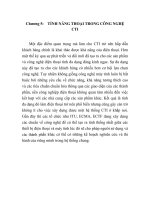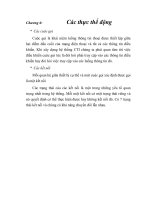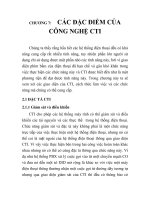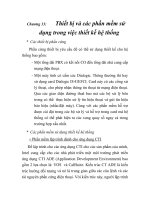jumo conductivity transmitter CTI 750 inductive
Bạn đang xem bản rút gọn của tài liệu. Xem và tải ngay bản đầy đủ của tài liệu tại đây (1.37 MB, 88 trang )
JUMO CTI-750
Inductive Conductivity/Concentration and
Temperature Transmitter with switch contacts
B 202756.0
Operating Instructions
2013-01-07/00452846
WARNING!
A sudden failure of the instrument or of a sensor connected to it could result in dangerous
overdosing. Please take suitable precautionary measures for this case.
NOTE!
All the nececssary settings are described in this manual. However, if any difficulties should
arise during start-up, please do not carry out any unauthorized manipulations. You could
endanger your righs under the instrument warranty!
NOTE!
Resetting the LC display
If the brightness/contrast setting is such that the text in the display is not readable, the
basic setting can be restored as follows:
✱ Switch off the supply voltage.
✱ Switch on the supply voltage and immediately keep the keys
and
held down.
Resetting the operating language to "English"
If the operating language has been set and you cannot understand the text of the display,
the language can be set to "English" with the Administrator password 7485. Thereafter, the
desired language can be set in ADMINISTRATOR LEVEL / DEVICE DATA / .... .
Contents
1
Typographical conventions ...................................................... 5
1.1
Warning signs ..............................................................................................5
1.2
Note signs ....................................................................................................5
2
General ....................................................................................... 6
2.1
Preface .........................................................................................................6
2.2
Device configuration ....................................................................................6
3
Inductive conductivity measurement ...................................... 8
3.1
Area of application .......................................................................................8
3.2
Function .......................................................................................................9
4
Instrument identification ........................................................ 10
4.1
Nameplate ..................................................................................................10
4.2
Type designation ........................................................................................11
4.3
The device as "Head transmitter" ..............................................................11
4.4
The device as "Transmitter with separate sensor" ....................................12
5
Instrument description ........................................................... 15
5.1
Technical data ............................................................................................15
6
Installation ............................................................................... 19
6.1
General .......................................................................................................19
6.2
Head transmitter dimensions .....................................................................20
6.3
Device with separate sensor ......................................................................24
6.4
Mounting examples ....................................................................................31
7
Installation ............................................................................... 35
7.1
General .......................................................................................................36
7.2
Electrical connection ..................................................................................37
8
Setup program ........................................................................ 42
8.1
Function .....................................................................................................42
9
Commissioning ....................................................................... 43
9.1
Head-mounted transmitter or transmitter with separate sensor ................43
9.2
Replacement sensor ..................................................................................43
Contents
10
Operation ................................................................................. 44
10.1
Controls ......................................................................................................44
10.2
Principle of operation .................................................................................46
10.3
Principle of operation .................................................................................48
10.4
Measurement mode ...................................................................................49
10.5
Operator level .............................................................................................49
10.6
Administrator level .....................................................................................57
10.7
Calibration level ..........................................................................................59
10.8
Dilution function .........................................................................................60
11
Calibration ............................................................................... 64
11.1
General .......................................................................................................64
11.2
Calibrating the relative cell constant ..........................................................64
11.3
Calibrating the temp. coefficient of the sample solution ...........................66
12
Maintenance ............................................................................ 74
12.1
Cleaning the conductivity sensor ...............................................................74
13
Eliminating faults and malfunctions ...................................... 75
13.1
Checking the instrument ............................................................................76
14
Appendix .................................................................................. 81
14.1
Before configuration ...................................................................................81
1 Typographical conventions
1.1
Warning signs
DANGER!
This symbol is used when there may be danger to personnel if the instructions are ignored or not followed correctly!
CAUTION!
This symbol is used when there may be damage to equipment or data if
the instructions are ignored or not followed correctly!
1.2
Note signs
NOTE!
This symbol is used when your special attention is drawn to a remark.
abc1
Footnote
Footnotes are remarks that refer to specific points in the text. Footnotes
consist of two parts:
A marker in the text, and the footnote text.
The markers in the text are arranged as continuous superscript numbers.
✱
Action instruction
This symbol indicates that an action to be performed is described.
The individual steps are marked by this asterisk.
Example:
✱ Remove crosspoint screws.
5
2 General
2.1
Preface
Please read these operating instructions before commissioning the instrument. Keep the manual in a place that is accessible to all users at all times.
NOTE!
All necessary settings are described in this manual. However, if any difficulties should still arise during start-up, please do not carry out any unauthorized manipulations. You could endanger your rights under the instrument
warranty!
Please contact the nearest subsidiary or the head office in such a case.
2.2
Device configuration
2.2.1
Device as head transmitter
Example
(1)
(1)
(2)
(2)
(3)
(4)
(4)
(3)
(1)
(2)
(3)
(4)
6
Transmitter (with and without graphic LCD display)
Process connection
Temperature probe
Inductive conductivity measurement sensor
2 General
2.2.2
Device with separate sensor
Example
(1)
(2)
(2)
(3)
(4)
(4)
(3)
(1)
(2)
(3)
(4)
Transmitter (with and without graphic LCD display)
Process connection
Temperature probe
Inductive conductivity measurement sensor
7
3 Inductive conductivity measurement
3.1
Area of application
General
The inductive measurement method permits largely maintenance-free
acquisition of the specific conductivity, even in difficult media conditions.
Unlike the conductive measurement method, problems such as electrode
decomposition and polarization do not occur.
Brief description
The instrument is used for the measurement/control of conductivity or
concentration in liquid media. It is particularly recommended for use in media
where severe deposits of dirt, oil, grease or gypsum/lime precipitates are to be
expected. The integrated temperature measurement enables fast and
accurate temperature compensation, which is of particular importance when
measuring conductivity. Additional functions, such as the combined
changeover of measurement range and temperature coefficient, enable
optimum application in CIP processes.
Two built-in switching outputs can be freely programmed to monitor limits for
conductivity/concentration and/or temperature. It is also possible to assign
alarm and control functions (dilution).
The instrument is operated either from the membrane keypad and plain-text
graphics display (operator language can be changed over) or through the userfriendly PC setup program. Simply rotating the housing cover makes it
possible to read the display, regardless of whether the installation is in
horizontally or vertically arranged pipes. By using the setup program, the
instrument configuration data for plant documentation can be saved and
printed out. To prevent any tampering, the instrument can also be supplied
without keypad or display. In this case, the setup program is needed for
programming.
The instrument is available either as a combined unit (transmitter and
measuring cell together in one unit) or as a split version (transmitter and cell
connected by cable). The split version is particularly suitable for plant
subjected to strong vibration and/or significant heat radiation at the point of
measurement, or for installation on sites that are difficult to access.
Typical areas of application
• CIP cleaning (CIP = Clean In Place/Process)
• concentration monitoring or dosing of chemicals
• food/beverage and pharmaceutical industries
• product monitoring (phase separation of product/product mix/water)
in the beverage industry, breweries, dairies
• control (e.g. phase separation of detergent/rinsing water in
cleaning processes, e.g. bottle cleaning plant, or for container cleaning)
8
3 Inductive conductivity measurement
3.2
Function
of the transmitter
The instrument has been designed for use on site. A rugged housing protects
the electronics and the electrical connections from corrosive environmental
conditions (enclosure IP67). As standard, the device has one analog signal
output each for conductivity/concentration and temperature respectively.
Further processing of the standard signals can take place in a suitable display/
control device, or, for example, directly in a PLC.
The output signals are electrically isolated from one another and from the
medium.
of the measuring cell
The conductivity is measured using an inductive probe. A sinusoidal a.c.
voltage feeds the transmitting coil. Depending on the conductivity of the liquid
to be measured, a current is induced in the receiver coil. This current is proportional to the conductivity of the medium. The cell constant of the inductive
probe depends on its geometry. The cell constant can also be affected by
components in the immediate vicinity.
(1)
(1)
(3)
(2)
(2)
(3)
(4)
(4)
(1)
(2)
(3)
(4)
Plastic body
Coils
Temperature sensor
Liquid loop
9
4 Instrument identification
4.1
Nameplate
on the transmitter
JUMO GmbH & Co. KG
Fulda, Germany
www.jumo.net
JUMO CTI-750
Type: 202756/15-607-0000-82/767,941
VARTN: 20/00544540
F No.: 12345678 01 0 1203 0001
DC 19...31 V Յ 3W
on the connecting cable (only with separate sensor)
CAUTION!
For devices with a separate sensor, the transmitter and detached sensor are
matched to one another at the factory!
When connecting the components, please note that the serial number of the
external sensor (marked on the label attached to the connecting cable) must
match the serial number marked on the nameplate of the transmitter!
NOTE!
The date of manufacture is coded in the “F No.” (serial number):
1203 means manufactured in year 2012/calendar week 03
10
4 Instrument identification
4.2
Type designation
4.3
The device as "Head transmitter"
(1)
202756
(2)
10
15
16
(3)
107
108
110
606
607
608
609
617
686
690
955
956
(4)
0000
(5)
82
83
84
(6)
268
767
768
844
941
a
b
c
d
e
f
g
h
i
Basic type
Inductive transmitter/switching device for conductivity/
concentration and temperature
Basic type extension
Head transmitter in plastic housing, without display/keypada
Head transmitter in plastic housing, with display/keypad
Head transmitter in stainless steel housing, with display/keypad
Process connection
Thread G 1 1/4 A
Thread G 1 1/2 A
Thread G 2 A
DN 40 screwed pipe fitting, DIN 11 851 (MK DN 40, milk cone)
DN 50 screwed pipe fitting, DIN 11851 (MK DN 50, milk cone)
DN 65 screwed pipe fitting, DIN 11851 (MK DN 65, milk cone)
DN 80 screwed pipe fitting, DIN 11851 (MK DN 80, milk cone)
Clamp 2 1/2"b
VARIVENT® DN 40/50 b, c, d
SMS 2"
Pressing screw G 1 A, EL= 57 mmc, e
Pressing screw G 1 A, EL= 87 mmc, e
Immersion length
See “Dimensions for head transmitter"
Electrical connection
Cable glands
M12 plug/socket connectors (instead of the cable glands)f
Two M16 cable glands and one blanking plugg
Extra code
Internal temperature sensor
Cell material PEEKh
Cell material PVDFi
Supply voltage 24 V AC
Hygienic design
The PC setup program is required for programming the instrument, see accessories.
Mounting items (mounting brackets) not included in delivery.
Only in conjunction with extra code 767 (cell material PEEK)
EHEDG-certified
Only in conjunction with extra code 268 (internal temperature sensor) and 767 (cell material PEEK).
Installation only in conjunction with process connection adapter, part no. 00530354 or 00530355!
If required, order 1 set M12 plug/socket connectors, part no. 00529482.
Standard on basic type extension 16
Temperature sensor always internal
Not in combination with extra code 941
11
4 Instrument identification
(1)
Order code
Order example
a
202756
(2)
/
/
10
(3)
-
607
(4)
-
0000
(5)
-
82
(6)
/
/
, ...a
767
List extra codes in sequence, separated by commas.
4.4
The device as "Transmitter with separate sensor"
(1)
202756
(2)
20
25
26
60
65
66
80
85
(3)
000
107
108
110
606
607
608
609
617
686
690
706
955
956
(4)
0000
0500
1000
1500
2000
xxxx
12
Basic type
Inductive transmitter/switching device for conductivity/
concentration and temperature
Basic type extension
Transmitter in plastic housing, without display/keypad (without sensor)a, b
Transmitter with display/keypad (without sensor)b
Transmitter in stainless steel housing, with display/keypad (without sensor)b
Transmitter without display/keypad including sensor (cable length 10 m)a
Transmitter with display/keypad including sensor (cable length 10 m)
Transmitter in stainless steel housing, with display/keypad including sensor
(cable length 10 m)
Replacement sensor with a 10 m long cable for transmitter in plastic housing
(without transmitter)b, c
Replacement sensor with a 10 m long cable for transmitter in stainless steel
housing (without transmitter)b, c
Process connection
Without process connection
Thread G 1 1/4 A
Thread G 1 1/2 A
Thread G 2 A
DN 40 screwed pipe fitting, DIN 11851(MK DN 40, milk cone)
DN 50 screwed pipe fitting, DIN 11851(MK DN 50, milk cone)
DN 65 screwed pipe fitting, DIN 11851(MK DN 65, milk cone)
DN 80 screwed pipe fitting, DIN 11851(MK DN 80, milk cone)
Clamp 2 1/2"c
VARIVENT® DN 40/50c, d, e
SMS 2"
Immersion modelf
Pressing screw G 1", EL = 57 mmd, g
Pressing screw G 1", EL = 87 mmd, g
Immersion length (see "Dimensions for separate sensor")f
Not available
500 mm
1000 mm
1500 mm
2000 mm
Special length (in 250 mm increments, e.g. 0250, 0750, 1250, 1750)
4 Instrument identification
(5)
21
82
83
84
(6)
000
268
767
768
844
941
a
b
c
d
e
f
g
h
i
j
Electrical connection
Fixed cable with M12 socket connector on separate sensor
Cable glands on the operating unit
M12 plug/socket connectors on operating unit
Two M16 cable glands and a blind grommeth
Extra code
No extra code
Internal temperature sensor
Cell material PEEKi
Cell material PVDFj
Supply voltage 24 V AC
Hygienic design
The PC setup program is required for programming the instrument, see accessories.
A calibration kit is absolutely essential for commissioning. If not available, please include in your order (see
accessories).
Mounting items (mounting brackets) not included in delivery.
Only in conjunction with extra code 767 (cell material PEEK)
EHEDG-certified
Only in conjunction with extra code 768 (cell material PVDF)
Only in conjunction with extra code 268 (internal temperature sensor) and 767 (cell material PEEK).
Installation only in conjunction with process connection adapter, part no. 00530354 or 00530355!
Standard on basic type extension 66
Temperature sensor always internal
Not in combination with extra code 941
(1)
Order code
Order example
a
202756
(2)
/
/
65
(3)
-
607
(4)
-
0000
(5)
-
82
(6)
/
/
, ...a
000
List extra codes in sequence, separated by commas.
13
4 Instrument identification
Accessories
Type
Flange DN 32, material: PP
Flange DN 50, material: PP
Weld-on threaded adapter DN 50, DIN 11851
Adapter Clamp 1“ - 1,5“ to G 1
Adapter MK DN 50 to G 1
Ring nut DN 50, DIN 11851
Ring nut SMS DN 2“, Mutter
M12 plug connector, 8-pole, straight, for assembly by user
M12 socket connector, 8-pole, straight, for assembly by user
M12 socket connector, 8-pole, straight, for assembly by user
M12 socket connector, 5-pole, straight, for assembly by user
Set socket connectors TZ 580 for 202755/202756
Cover with LC-display and keyboard
Cover with LC-display and keyboard for VA-version
DIN rail mounting set
Pipe installation kit
Switching mode power supply, type PS5R-A24 for DIN rail mounting;
Input voltage 100 ... 240 V AC
Adjustment set (for calibrating a replacement transmitter)
PC interface (USB/TTL), 2 adapter setup cable
Part No.
00083375
00083376
00085020
00530354
00530355
00343368
00345162
00444307
00486503
00444312
00444313
00529482
00443725
00525488
00459903
00515128
00374661
00459436
00456352
Software
Type
Setup
14
Part No.
00454710
5 Instrument description
5.1
Technical data
5.1.1
Conductivity transmitter
A/D converter
Resolution
Sampling time
Power supply
Standard
Residual ripple
Reverse polarity protection
Extra code 844
Power draw
with display
without display
Contact rating
of the photo MOS relay
Voltage
Current
Electrical connection
82
83
84
Display
Basic type extension 10
Basic type extension 15
Basic type extension 16
Permissible ambient
temperature
Permissible storage
temperature
Protection ratinga
Electromagnetic
compatibilityb
Interference emission
Interference immunity
Housing
Basic type extensions 10, 15,
20, 25, 60, 65
Basic type extensions 16, 26,
66
Weightc
a
b
15 bits
500 ms = 2 measurements/s
For SELV and PELV circuit operation only.
19 - 31 V DC (24 V DC nominal)
<5 %
yes
24 V DC ±10 %, 50 - 60 Hz
3W
2,6 W
50 V AC/DC
200 mA
Cable glands/pluggable screw terminals, 2,5 mm2
M12 plug/socket (instead of cable glands)
Two M16 cable glands and a pluggable screw terminal blanking
plug, 2,5 mm2
without dsplay
Backlit graphic LCD; adjustable contrast; dimensions:
62 mm × 23 mm
Backlit graphic LCD; adjustable contrast; dimensions:
62 mm × 23 mm
5 to +50 °C; max. rel. humidity. 93 %, no condensation
-10 to +75 °C; max. rel. humidity. 93 %, no condensation
IP67
Class B
to industrial requirements
PA
Stainless steel 1.4305 (AISI 303)
approx. 0,3 - 2,4 kg
DIN EN 60529
DIN EN 61326
15
5 Instrument description
c
Dependent on version and process connection
5.1.2
Measuring ranges
There is a choice of four different measuring ranges. Any one of these ranges
can be activated by an external switch or by a PLC.
NOTE!
The overall accuracy is composed of transmitter accuracy plus sensor
accuracy.
Transmitter
measuring ranges
0 - 500 µS/cm
0 - 1000 µS/cm
0 - 2000 µS/cm
0 - 5000 µS/cm
0 - 10 mS/cm
0 - 20 mS/cm
0 - 50 mS/cm
0 - 100 mS/cm
0 - 200 mS/cm
0 - 500 mS/cm
0 - 1000 mS/cm
0 - 2000 mS/cma
Concentration measurement
NaOH (caustic soda)
HNO3 (nitric acid)
Customer-specific
concentration curve
Calibration timer
Output signal conductivity
and concentrationb
Burden
at current output
at voltage output
Ambient temperature effect
Analog output at "Alarm"
Low
High
a
b
Accuracy (as % of measuring range span)
0,5 %
implemented in the device software
0 - 15 % by weight or 25 - 50 % by weight (0 - 90 °C)
0 - 25 % by weight or 36 - 82 % by weight (0 - 80 °C)
freely programmable via the setup program (see "Special
functions")
0 - 999 days (0 = OFF)
0 - 10 V or 10 - 0 V
2 - 10 V or 10 - 2 V
0 - 20 mA or 20 - 0 mA
4 - 20 mA or 20 - 4 mA
500
2k
0,1 %/K
0 mA/0 V/3.4 mA/1.4 V or a fixed value
22.0 mA/0.7 V or a fixed value
Not temperature compensated.
The output signal is freely scalable.
16
5 Instrument description
5.1.3
Temperature transmitters
Temperature acquisitiona
Measuring range
Characteristic
Accuracy
Ambient temperature effect
Output signal
Burden
at current output
at voltage output
Analog output at "Alarm"
Low
High
a
Manually, -20.0 to 25.0 to 150 °C or °F, or automatically
-20 - 150 °C or °F
linear
0.5 % of the measuring range
0.1 %/K
0 - 10 V or 10 - 0 V
2 - 10 V or 10 - 2 V
0 - 20 mA or 20 - 0 mA
4 - 20 mA or 20 - 4 mA
The output signal is freely scalable in the -20 to +200°C range.
500
2k
0 mA/0 V/3.4 mA/1.4 V or a fixed value
22.0 mA/10.7 V or a fixed value
Take the permissible sample medium temperature into consideration!
5.1.4
Temperature compensation
Reference temperature
Temperature coefficient
Compensation range
Function
15 to 30 °C, adjustable
5.5 %/°C, adjustable
-20 to 150 °C
linear or
natural water (EN 27888) or
non-linear (learning function, see Special functions
17
5 Instrument description
5.1.5
Inductive conductivity sensor
Measuring range
0 - 500 µS/cm
0 - 1000 µS/cm
0 - 2000 µS/cm
0 - 5000 µS/cm
0 - 10 mS/cm
0 - 20 mS/cm
0 - 50 mS/cm
0 - 100 mS/cm
0 - 200 mS/cm
0 - 500 mS/cm
0 - 1000 mS/cm
0 - 2000 mS/cma
Material
for extra code 767
for extra code 768
Permissible sample
medium temperatures
Pressure
a
Accuracy (as % of measuring range span)
1%
1%
0,5 %
0,5 %
0,5 %
0,5 %
0,5 %
0,5 %
0,5 %
0,5 %
1%
1%
PEEK
PVDF
-10 - +120 °C, briefly +140 °C (sterilization)
max. 10 bar
Not temperature compensated
NOTE!
The temperature, pressure and process medium influence the operating life
of the measuring cell.
18
6 Installation
6.1
General
6.1.1
Installation location
Make sure that the site is readily accessible, for calibration at a later time.
The fixing must be secure and free from vibration.
Avoid direct sunlight!
Take care that there is adequate flow through and around the sensor (2)!
If the device is to be mounted in a pipeline, there must be at least 20 mm
clearance between the sensor and the wall of the pipe.
If it is not possible to achieve this minimum clearance, then a limited
compensation can be made through the "Mounting factor" parameter.
For submerged operation in basins, a location must be chosen that is
representative of the typical conductivity or concentration.
6.1.2
Mounting location
The device can be mounted in any position.
The display can be adjusted by means of a captive screw according to the
mounting direction.
(1)
(2)
(3)
ACHTUNG!
With head transmitters, the PG cable glands (1) must point in the flow
direction!
With separate conductivity sensors, the flow direction is indicated by a dot
on the upper part of the sensor.
This dot must point in the flow direction!
With "overhead installation" the black breather (2) points upwards. In this
case, no liquid (such as condensate) must be allowed to block the breather
(2)!
6.1.3
Screwing the separate sensor in and out
CATUION!
The cable must not be twisted!
Avoid forcefully tugging the cable, especially suddenly.
19
6 Installation
6.2
Head transmitter dimensions
6.2.1
Operating device
Head transmitter in a plastic casing
for basic type extensions 10 or 15 and electrical connection 83
M12 flush-type connector
5-pin
M12 flush-type connector
8-pin
M12 flush-type connector
8-pin
6.2.2
M12 socket
(PBT / PA)
Process connections
36
36
1
1
1
2
3
Version with process connection
108 = screw-in thread G 1 1/2 A
110 = screw-in thread G 2 A
and extra code 767
1 = stianless steel 1.4301
20
2 = PEEK
Version with process connection
107 = screw-in thread G 1 1/4 A
108 = screw-in thread G 1 1/2 A
110 = screw-in thread G 2 A
and extra code 768
3 = PVDF
6 Installation
1
2 (607)
1
1
1
1
2
3
Version with process connection
607 = MK DN 50
608 = MK DN 65
609 = MK DN 80
and extra code 767
1 = stainless steel 1.4301
2 = PEEK
Version with process connection
606 = MK DN 40
607 = MK DN 50
608 = MK DN 65
609 = MK DN 80
and extra code 768
3 = PVDF
21
6 Installation
1
1 (617)
2 (616)
1
2
3
Version with process connection
616 = Clamp 2"
617 = Clamp 2 1/2"
and extra code 767 and 941
(retaining clip not included in delivery)
Version with process connection
617 = Clamp 2 1/2"
and extra code 768
(retaining clip not included in delivery)
4
1
2
Version with process connection
686 = VARIVENT® DN 40/50
and extra code 767 and 941
(retaining clip not included in delivery)
1 = stainless steel 1.4301
22
2 = PEEK
3 = PVDF
4 = PPS GF 40
6 Installation
1
1
1
1
2
B
3
Version with process connection
690 = SMS 2"
and extra code 767 and 941
Version with process connection
690 = SMS 2"
and extra code 768
36
36
1
1
2
1
2
Version with process connection
955 = Pressing screw G 1"
EL = 57 mm
1 = stainless steel 1.4301
2 = PEEK
Version with process connection
956 = Pressing screw G1"
EL = 87 mm
3 = PVDF
1 = stainless steel 1.4301 2 = PEEK
3 = PVDF
1 = stainless steel 1.4301 2 = PEEK
3 = PVDF
4 = PPS GF 40
23
6 Installation
6.3
Device with separate sensor
6.3.1
Operating device
Transmitter with a separate sensor, in a plastic casing
with basic type extensions 26 or 66 and electrical connection 83
6.3.2
Drilling template for wall mounting
(1)
(2)
(1)
(2)
24
Knock-through plugs (×4)
Venting element, PBT
6 Installation
6.3.3
Process connections
6
4
5
5
36
36
1
1
2
3
Version with process connection
108 = screw-in thread G 1 1/2 A
110 = screw-in thread G 2 A
and extra code 767
1 = stainless steel 1.4301
2 = PEEK
Version with process connection
107 = screw-in thread G 1 1/4 A
108 = screw-in thread G 1 1/2 A
110 = screw-in thread G 2 A
and extra code 768
3 = PVDF
4 = PBT
5 = PA
6 = TPU
25









